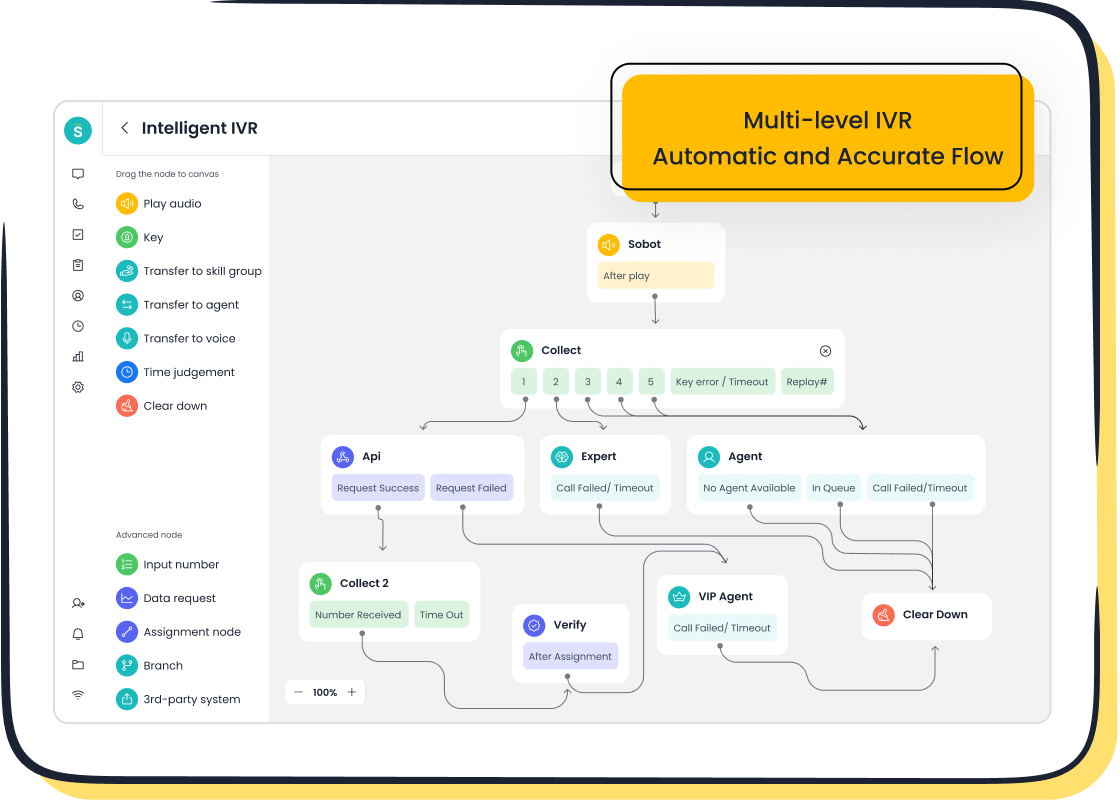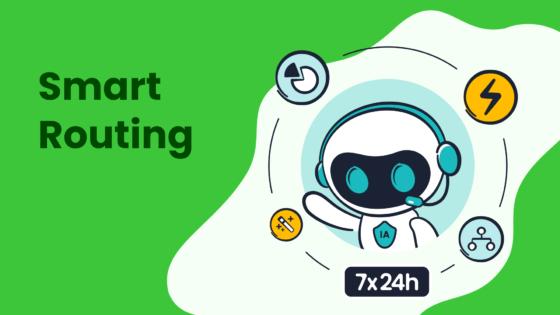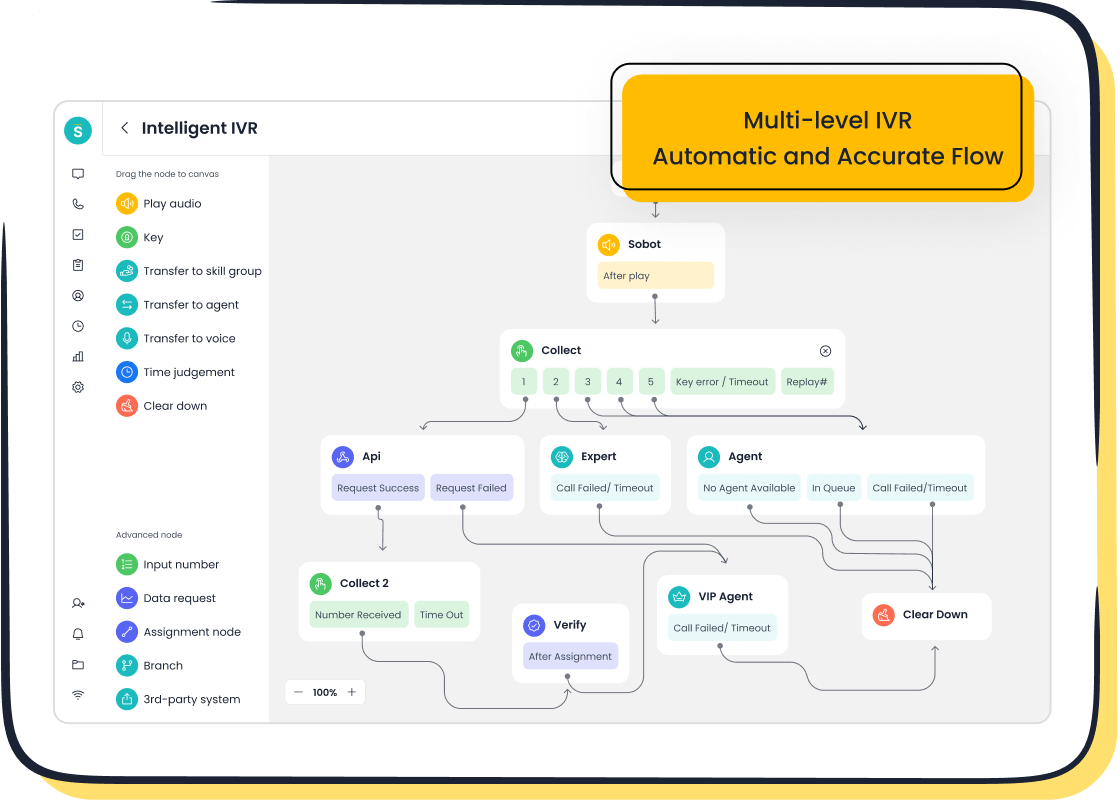Top Call Centre Automation Solutions Terms for Agents

Many agents now work in call centers where call centre automation solutions shape daily tasks and customer interactions. Sobot call center platforms, including Sobot AI, help agents manage calls and automate routine work. Today, about 25% of call centers have adopted call centre automation solutions, with rapid growth expected. Mastering these terms boosts agent efficiency, improves First Call Resolution rates, and increases customer satisfaction. Agents using call centre automation solutions see less stress and deliver more personalized service, helping them excel in modern call centers.
Key Definitions in Call Centre Automation
Understanding contact center terminology is essential for agents working in today’s automated environments. The following table summarizes some of the most important terms in call center terminology, followed by detailed explanations and real-world examples. These definitions help agents navigate daily tasks and leverage advanced features in platforms like Sobot’s Voice/Call Center.
| Term | Definition |
|---|---|
| Interactive Voice Response (IVR) | An automated system that uses pre-recorded menus and voice or keypad inputs to resolve queries and route calls. |
| Automatic Call Distribution (ACD) | A system that routes incoming calls to the right agent based on rules like skill, priority, or customer data. |
| Auto Dialer | A tool that automatically dials numbers from a list and connects answered calls to agents. |
| CRM | Customer Relationship Management system that stores and manages customer data and interactions. |
| Call Routing | The process of directing calls to the most suitable agent or department based on set criteria. |
| Abandoned Call | A call where the customer hangs up before reaching an agent, often tracked by average time to abandon. |
IVR
Interactive voice response (IVR) stands as a foundational technology in contact center terminology. IVR systems use automated menus and prompts to interact with callers. Customers respond using their voice or keypad, allowing the system to resolve simple queries or direct calls to the right department. For example, a caller might press “1” for billing or say “support” to reach technical help.

Sobot’s Voice/Call Center offers an intelligent IVR feature. Agents benefit from customizable greetings, real-time menu updates, and drag-and-drop configuration. This flexibility reduces manual call handling and improves customer satisfaction. IVR systems also help lower operational costs by automating routine inquiries.
Tip: IVR can handle high call volumes during peak times, ensuring customers receive timely responses even when agents are busy.
ACD
Automatic call distribution (ACD) is another core term in contact center terminology. An ACD system automatically routes incoming calls to the most appropriate agent or team. It uses rules based on agent skills, customer history, or call priority. This process ensures that customers connect with someone who can resolve their issue quickly.
Sobot’s platform integrates automatic call distribution seamlessly. The system analyzes incoming calls and matches them with available agents who have the right expertise. This reduces wait times and increases first call resolution rates. ACD also supports advanced features like skill-based routing and real-time monitoring.
Note: Efficient ACD systems can improve customer satisfaction scores by minimizing transfers and hold times.
Auto Dialer
Auto dialers automate outbound calling, a key part of modern call center terminology. These tools dial numbers from a list and connect answered calls to agents. There are several types, including predictive and progressive dialers. Predictive dialers use algorithms to optimize call timing, while progressive dialers call one number at a time as agents become available.
Sobot’s Voice/Call Center includes bulk outbound task automation. Agents can schedule campaigns, assign leads, and track results. Auto dialers help increase agent productivity by reducing idle time and ensuring more customer connections per hour.
Auto dialers are especially useful for sales, collections, and customer follow-up campaigns.
CRM
Customer Relationship Management (CRM) systems play a central role in contact center terminology. A CRM stores customer information, call history, and interaction records. Agents use CRM data to personalize conversations, track issues, and follow up on previous requests.
Sobot’s unified workspace integrates CRM features directly into the agent interface. This allows agents to view customer profiles, update records, and access past interactions without switching screens. CRM integration streamlines workflows and supports better customer experiences.
Example: When a customer calls, the agent sees their purchase history and previous support tickets, enabling faster and more informed service.
Call Routing
Call routing refers to the process of directing incoming calls to the right agent or department. Effective call routing uses criteria such as language preference, issue type, or customer status. This ensures that customers reach someone who can help them on the first try.
Sobot’s smart call routing uses AI and rule-based workflows to automate this process. The system evaluates each call and routes it based on predefined rules or real-time data. Smart call routing reduces misdirected calls and improves first call resolution.
Fact: According to industry studies, smart call routing can reduce average handle time by up to 20% (source).
Abandoned Call
An abandoned call occurs when a customer hangs up before speaking to an agent. This metric is critical in contact center terminology because it reflects customer frustration and potential lost business. The average time to abandon measures how long callers wait before disconnecting.
Sobot’s monitoring and analysis tools track abandoned calls and calculate the average time to abandon. Agents and managers use these insights to adjust staffing, improve IVR menus, or optimize call routing. Reducing abandoned calls leads to higher customer satisfaction and better operational efficiency.
Tip: Monitoring the average time to abandon helps identify bottlenecks in the call flow and highlights areas for improvement.
Agents who understand these key terms in call center terminology can better navigate automated systems and deliver superior customer service. Sobot’s Voice/Call Center aligns with industry standards by offering intelligent IVR, advanced automatic call distribution, and integrated CRM capabilities. These features empower agents to work efficiently and meet customer needs in a fast-paced environment.
Automation Technologies for Call Centers

Modern call centers rely on advanced automation technologies to deliver seamless customer experience management and boost agent productivity. Sobot’s cloud contact center platform and AI Solution offer a comprehensive suite of tools that transform daily operations. These technologies streamline workflows, reduce manual effort, and enable agents to focus on complex customer needs.
AI and Voicebot
AI and voicebot technology have become essential in the evolution of the cloud contact center. These solutions use conversational ai to interact with customers, answer questions, and automate routine tasks. Sobot’s AI-powered Voicebot recognizes intent, provides instant responses, and supports multilingual interactions. This technology handles high call volumes, freeing agents to address more complex issues.
- Voicebots now manage appointment scheduling, frequently asked questions, and account inquiries across industries like healthcare, banking, and retail.
- Retailers report a 30% reduction in support costs after implementing voicebots.
- Companies using AI-driven voice technology see operational cost reductions of 20% to 60% and a 25-30% increase in customer satisfaction.
- Up to 50% of current call volumes are projected to shift to AI-driven self-service soon.
- 80% of businesses plan to adopt AI-driven voice technology by 2026.
- Voice AI reduces call handling time by 35% and queue times by up to 50%.
Sobot’s Voice/Call Center integrates seamlessly with existing systems, supporting hybrid models where AI handles routine queries and agents resolve complex cases. This approach ensures a balance between automation and human touch, which 59% of consumers still prefer for complicated issues.
AI voicebots not only improve efficiency but also enhance customer experience management by providing fast, accurate, and consistent service.
Chatbot
Chatbots represent another key advancement in conversational ai for the cloud contact center. These automated agents engage customers through chat, providing instant answers and guiding users through processes. Sobot’s AI-powered chatbot operates 24/7, handling inquiries across multiple channels, including web, social media, and messaging apps.
Real-world implementations show that chatbots can resolve up to 80% of Level 1 and Level 2 queries. This automation reduces resolution time and allows agents to focus on higher-value tasks. Chatbots also automate ticket routing, draft personalized responses, and update knowledge bases, further streamlining agent workflows.
Agents benefit from reduced manual workload and faster response times, leading to improved employee satisfaction and superior customer experiences.
Unified Workspace
A unified workspace consolidates all customer interactions, data, and tools into a single interface. Sobot’s unified workspace brings together calls, messages, tickets, and customer profiles, powered by conversational ai and automation. Agents access everything they need without switching between systems, which increases productivity and reduces errors.
AI virtual assistants within the workspace automate knowledge creation and provide contextual answers. Integration with CRM and other enterprise systems ensures agents have up-to-date information at their fingertips. This technology enables effective collaboration between teams and AI agents, streamlining workflows and increasing efficiency.
Unified workspaces empower agents to deliver personalized service and resolve issues quickly, enhancing customer experience management.
Monitoring and Analysis
Monitoring and analysis tools play a vital role in the cloud contact center. Sobot’s platform offers real-time monitoring of call data, agent performance, and customer interactions. These analytics provide actionable insights that drive continuous improvement.
Managers track key metrics such as average handle time, first call resolution, and customer satisfaction scores. Data-driven decision making helps optimize staffing, identify training needs, and refine call routing strategies. Automation technologies also generate comprehensive reports, enabling proactive management of service quality.
Regular analysis of performance metrics leads to better outcomes for both agents and customers.
Smart Call Routing
Smart call routing uses conversational ai and automation to direct customers to the most suitable agent or channel. Sobot’s smart call routing evaluates each inquiry based on real-time data, customer context, and predefined rules. This technology reduces wait times, eliminates bottlenecks, and ensures customers reach the right person on the first attempt.
- Smart call routing dynamically matches customers to agents, optimizing productivity and operational efficiency.
- It supports omnichannel experiences, allowing seamless transitions across phone, email, chat, and social media.
- Integration with CRM provides agents with critical customer information, reducing the need for customers to repeat themselves.
- 96% of consumers expect to avoid repeating information when transferred, highlighting the importance of intelligent routing.
A concrete example comes from Wyze Labs, which achieved a 98% improvement in first call resolution after implementing intelligent call routing. This improvement directly correlates with higher customer satisfaction and fewer callbacks (source).
Smart call routing not only improves customer experience management but also reduces operational costs by increasing first attempt resolution.
Omnichannel Support
Omnichannel support enables customers to interact with the cloud contact center through their preferred channels—phone, chat, email, social media, and more. Sobot’s omnichannel platform unifies these channels, providing agents with a complete view of each customer’s journey.
- Customers switch channels seamlessly without repeating information, reducing friction and improving satisfaction.
- Omnichannel engagement prevents channel congestion, distributes contacts efficiently, and reduces wait times and call abandonment.
- AI-powered tools automate routine inquiries and provide agents with comprehensive customer histories for faster, more personalized service.
- Real-world data shows a 41% increase in first contact resolution and a 30% reduction in escalations after implementing omnichannel engagement.
- Omnichannel platforms improve agent productivity, reduce operational costs, and foster customer loyalty.
Agents benefit from a single interface that consolidates all communication, making it easier to manage interactions and deliver consistent service. The seamless, personalized experience created by omnichannel strategies enhances customer trust and retention.
Omnichannel support, powered by conversational ai and automation, is essential for modern customer experience management in the cloud contact center.
Sobot’s cloud contact center and AI Solution exemplify the power of automation and conversational ai in transforming call center operations. These technologies enable businesses to deliver superior customer experience management, reduce costs, and increase efficiency. As more organizations adopt contact center as a service models, the integration of advanced technology becomes a key differentiator in the competitive landscape.
Call Center Analytics and Metrics

Call center analytics play a vital role in measuring and improving agent performance. Sobot’s Voice/Call Center platform uses advanced analytics to track every key performance indicator (KPI) that matters for modern contact centers. These metrics help leaders set realistic goals, optimize workflows, and deliver a better voice of the customer experience.
Average Handle Time (AHT)
Average handling time is a core KPI in call center analytics. It measures the average duration an agent spends handling a customer call, including talk time, hold time, and after-call work. Sobot’s real-time dashboards display AHT for each agent, helping managers identify trends and areas for improvement. Lower AHT often means agents resolve issues quickly, but it must balance with customer satisfaction to avoid rushed service.
AHT = (Total Talk Time + Hold Time + After-Call Work) / Number of Calls Handled
First Call Resolution (FCR)
First contact resolution is another essential KPI. It tracks the percentage of customer issues resolved during the first interaction. High FCR rates indicate agents have the knowledge and tools to solve problems without transfers or callbacks. Sobot’s AI-powered smart routing connects customers to the right agent, boosting FCR and reducing repeat calls. Improving FCR by just 1% can lower operating costs and increase satisfaction by the same margin.
Customer Satisfaction (CSAT)
Customer satisfaction is a direct measure of how happy customers feel after an interaction. Sobot’s platform collects CSAT scores through post-call surveys, providing instant feedback. Industry benchmarks suggest a CSAT score of 85% or higher is ideal for automated call centers. High CSAT reflects effective handling, quick speed, and a positive voice of the customer.
Net Promoter Score (NPS)
Net Promoter Score is a KPI that measures customer loyalty and their likelihood to recommend the service. Sobot enables automated NPS surveys, helping businesses track trends over time. A score above 50 is considered excellent. NPS, combined with CSAT, gives a complete view of customer satisfaction and business intelligence.
Agent Analytics
Agent analytics provide deep insights into individual and team performance. Sobot’s AI-driven business intelligence tools analyze call data, customer sentiment, and script effectiveness. Automated speech analytics detect emotions and highlight coaching opportunities. Real-time analytics allow supervisors to adjust staffing and workflows, improving speed and handling efficiency.
| Metric | Description | Measurement Method |
|---|---|---|
| AHT | Average time spent handling calls | Dashboard calculation |
| FCR | Issues resolved on first contact | Call logs and resolution tracking |
| CSAT | Customer satisfaction after interaction | Post-call surveys |
| NPS | Customer loyalty and advocacy | Periodic surveys |
| Agent Analytics | Insights into agent performance and efficiency | AI-driven business intelligence |
Regular monitoring of these KPIs ensures continuous improvement and higher satisfaction for both agents and customers.
Essential Processes in Call Centre Automation Solutions
Omnichannel Integration
Omnichannel integration stands as a core process in modern call centre automation solutions. Sobot’s platform unifies all communication channels—phone, chat, email, social media, and messaging—into a single interface. Agents access complete customer histories, which reduces the need for customers to repeat information. Real-time data synchronization and CRM integration help agents respond quickly and accurately. This approach improves average handle times by up to 30% and increases customer satisfaction by 25% (source). Automated self-service tools, such as chatbots and IVR, further reduce agent workload and support higher employee satisfaction.
Workforce Management
Workforce management tools in call centre automation solutions help forecast call volumes, schedule agents, and monitor performance. Sobot’s platform automates scheduling and tracks time spent on calls and tickets. This reduces paperwork and increases productivity. Automated workforce management saves up to 25% of time compared to manual methods. Accurate forecasting ensures the right number of agents are available, which helps maintain service levels and boosts employee satisfaction. Real-time reporting allows supervisors to address inefficiencies quickly and keep teams engaged.
- Automates forecasting and scheduling
- Provides real-time performance metrics
- Integrates with popular business tools
Quality Assurance
Quality assurance (QA) automation ensures consistent service and compliance. Sobot’s QA tools use AI-driven sentiment analysis and automated scoring to evaluate customer interactions. These tools provide objective feedback, reduce human error, and support agent coaching. Real-time QA feedback helps agents improve, while automated scorecards track key metrics like customer satisfaction and call resolution. QA automation also enforces script adherence and regulatory compliance, which protects both customers and the business.
Automated QA processes lead to higher service quality and greater employee satisfaction.
Knowledge Management
Knowledge management systems play a vital role in call centre automation solutions. Sobot’s knowledge base provides agents with quick access to accurate information, reducing call handling times and improving first call resolution. Centralized knowledge eliminates silos and supports consistent responses. Automated answer recommendations help agents resolve cases faster. Regular audits keep the knowledge base up to date, supporting ongoing training and employee satisfaction.
- Reduces call handling times
- Standardizes responses
- Supports agent training and productivity
Business Process Outsourcing (BPO)
Business process outsourcing (BPO) remains a key strategy for many organizations using call centre automation solutions. The global BPO market reached $339.5 billion in 2022 and continues to grow. Sobot’s platform supports BPO operations with scalable infrastructure, AI-powered automation, and multilingual support. BPO centers benefit from cost savings of 30-50%, operational flexibility, and access to specialized expertise. Automation in BPO environments handles routine inquiries, allowing agents to focus on complex issues and improving employee satisfaction.
- Enables 24/7 service availability
- Reduces operational costs
- Enhances scalability and quality
Abbreviations and Acronyms in Call Center Automation
Understanding abbreviations and acronyms is essential for anyone working with contact center terminology. These short forms help agents communicate efficiently and navigate complex systems. The following sections break down the most common acronyms found in modern call centers, making daily operations smoother and more effective.
IVR, ACD, CTI, CRM
Agents encounter several foundational acronyms in contact center terminology. Here is a quick reference table:
| Abbreviation/Acronym | Full Form | Explanation |
|---|---|---|
| IVR | Interactive Voice Response | Technology that lets customers interact with phone systems using voice or keypad inputs. |
| ACD | Automatic Call Distribution | System that routes incoming calls to the best-suited agent based on skills or availability. |
| CTI | Computer Telephony Integration | Connects phone systems with computers, giving agents access to customer data and call controls. |
| CRM | Customer Relationship Management | Software that stores and manages customer information and interaction history. |
Agents who understand these acronyms can use features like screen pops, call routing, and CRM integration more effectively. For example, Sobot’s Voice/Call Center leverages CTI to display customer details instantly, helping agents personalize service and reduce repetition. IVR and ACD work together to streamline call flows, letting agents focus on complex issues while automation handles routine tasks.
Mastery of these acronyms boosts agent confidence and improves first contact resolution.
CSAT, NPS, FCR, AHT
Performance metrics in contact center terminology often appear as acronyms. Each one provides insight into service quality and efficiency.
- CSAT (Customer Satisfaction Score): Measures how satisfied customers feel after an interaction.
- NPS (Net Promoter Score): Indicates customer loyalty by asking how likely they are to recommend the company.
- FCR (First Call Resolution): Tracks the percentage of issues solved on the first contact.
- AHT (Average Handle Time): Calculates the average time spent on each call, including talk, hold, and after-call work.
These acronyms help managers and agents monitor performance and set improvement goals. Sobot’s analytics dashboard displays these metrics in real time, supporting data-driven decisions. High FCR and CSAT scores signal effective service, while balanced AHT ensures agents resolve issues efficiently without rushing.
Metrics like CSAT, NPS, FCR, and AHT act as diagnostic tools, helping call centers balance speed, quality, and customer experience (source).
ACW, EOS, BPO, QA
Process-related acronyms also play a key role in contact center terminology. The table below explains their meaning and relevance to automation:
| Acronym | Meaning | Automation Relevance |
|---|---|---|
| ACW | After-Call Work | Post-call tasks that can be automated to save time and improve accuracy. |
| EOS | End of Service | Marks the end of daily operations; automation ensures smooth closure of activities. |
| BPO | Business Process Outsourcing | Outsourcing tasks, often using automation to boost efficiency and reduce costs. |
| QA | Quality Assurance | Automated tools monitor and score calls, supporting consistent service quality. |
Sobot’s platform automates ACW and QA processes, allowing agents to focus on customer needs. Automation in BPO environments increases scalability and service quality. EOS automation ensures that call centers close operations smoothly and on schedule.
Familiarity with these acronyms helps agents adapt quickly to new technologies and processes in the evolving contact center landscape.
Mastering call centre automation solutions terms empowers agents to resolve issues faster, deliver personalized service, and boost customer satisfaction. Agents who stay updated on new technologies—like Sobot’s AI-powered tools—gain confidence and adapt quickly to evolving customer needs. Ongoing training, real-time AI support, and access to unified workspaces help agents excel in their roles.
Agents who understand these terms not only improve their own performance but also contribute to a more efficient, customer-focused contact center.
FAQ
What are the main benefits of call centre automation solutions for agents?
Call centre automation solutions help agents save time, reduce errors, and handle more calls. Sobot’s platform automates routine tasks, which increases productivity by up to 30%. Agents can focus on complex issues and deliver better customer service.
How does Sobot ensure data security in its call centre automation solutions?
Sobot uses encrypted data transfer and complies with global security standards. The system maintains a 99.99% uptime and supports GDPR compliance. This protects customer information and ensures safe operations for all users. Learn more at Sobot Security.
Can call centre automation solutions improve customer satisfaction?
Yes. Automated features like IVR, smart call routing, and AI chatbots resolve issues faster. Sobot’s clients, such as Agilent, have seen customer satisfaction scores reach 95% after adopting Sobot’s call centre automation solutions. Fast responses and accurate information drive higher satisfaction.
What types of businesses benefit most from call centre automation solutions?
Businesses in retail, finance, gaming, and enterprise services use call centre automation solutions to manage high call volumes. Sobot supports over 10,000 brands, including Samsung and HP, helping them unify customer interactions and improve efficiency.
How do call centre automation solutions support omnichannel communication?
Call centre automation solutions like Sobot’s unify phone, chat, email, and social media in one workspace. Agents see all customer interactions in real time. This integration reduces repeated questions and improves first call resolution rates by up to 41% (source).
See Also
Understanding The Efficient Operation Of Call Center Automation
Effective Strategies For Managing Call Center Quality
Leading Artificial Intelligence Tools For Enterprise Contact Centers
Key Functionalities To Look For In CRM Call Center Software
An In-Depth Review Of AI Solutions For Enterprise Call Centers
